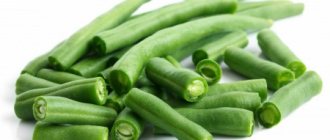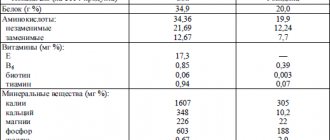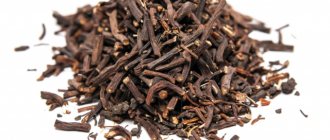Green beans are legumes that are famous for their rich chemical composition and high amount of fiber. It is nutritious, healthy and can become the basis of the diet of a person who is losing weight or has health problems. In small quantities it almost never causes allergic reactions or side effects. With regular and excessive use, you should make sure that there are no contraindications. Beans are especially valuable for children, pregnant and lactating women. Depending on the storage conditions and method of preparation, its composition and nutritional value changes.
Dietary properties of green beans:
How many calories are in green beans, what dietary properties they have, all this is of interest to those who lead a healthy lifestyle and monitor their health and figure. So we will try to answer these questions in the next article.
So here it is:
Beans are very popular due to their unique dietary properties and the content of a large number of useful vitamins and microelements.
Among the vitamins, it should be noted such as B vitamins, including folic acid and vitamins B1, B2, B5, B6, B9, as well as vitamins C, E and of course carotene. Beans are rich in useful micro and macroelements, such as iron, phosphorus, potassium, sodium, magnesium, calcium and others. Beans are high in fiber and protein. Fiber, by the way, is not rough, but rather gentle, just the kind that will help remove toxins from the human body, which makes it a desirable component of many diets, including diets for weight loss.
Beans, in the form of young pods, are recommended for people suffering from anemia or anemia. This product is also very useful for normalizing the function of the liver, kidneys, respiratory system, and even strengthening the nervous system. Green beans can and do lower blood sugar levels due to the presence of an insulin-like substance called arginine in this plant. If you regularly consume beans as a food product, then it is quite possible for diabetic patients to reduce their insulin doses.
Beans are very useful for normalizing the digestive system. It will not interfere with the normalization of the cardiovascular system, since iron, which is contained in large quantities in beans, can stimulate the formation of red blood cells. The calming properties of beans have also been noted. Those who often eat beans of all types have a balanced and calm character.
Composition and calorie content
Green beans are low in calories. Per 100 grams of product there are only 24-30 kcal, while the energy value is about 130 kJ. Calorie content depends on the cooking method and the type of beans. BJU per 100 g:
- proteins - 2.6 g;
- fats - 0.31 g;
- carbohydrates - 3.0 g;
- dietary fiber - 3 g;
- water - 90 g.
Green beans contain the following vitamins:
- A - 67 mcg;
- B1 (thiamine) - 0.1 mg;
- B2 (riboflavin) - 0.2 mg;
- B5 (pantothenic acid) - 0.2 mg;
- B6 (pyridoxine) - 0.16 mg;
- B9 (folate) - 36 mcg;
- C (ascorbic acid) - 20 mg;
- E (tocopherol) - 0.3 mg;
- RR - 0.9 mg.
The composition includes many macro- and microelements, such as:
- potassium;
- magnesium;
- sodium;
- calcium;
- phosphorus;
- manganese;
- iron.
100 g of green beans contains 0.1 mg of saturated fat.
The nutritional value of the product makes it useful and popular among different categories of people. Legumes are rich in fiber, sugars and other chemical elements necessary for the normal functioning of the body . Able to meet the daily needs of many nutrients.
Application in weight loss
Beans can be used as part of various weight loss diets due to their following properties:
- The dietary fiber contained in legumes provides a quick feeling of fullness, which will help prevent overeating.
- Due to the high protein content, the body becomes full faster, maintaining stable blood sugar levels, which in turn reduces cravings for sweet and high-calorie foods.
- Beans stimulate the body's production of the hormone cholecystokinin, which improves metabolism in the body, promoting the rapid breakdown of fats.
- Substances contained in beans prevent the digestion of starch, resulting in the body receiving fewer calories.
Product selection and storage
If you decide to purchase fresh green beans, you should know what characteristics the fresh product has:
- The pods should be resilient;
- There should be no damage or stains;
- The color is dark green.
A fresh plant can be stored for no more than 7 days in the refrigerator, so you should not buy the product for future use.
More often in grocery stores you can find frozen green beans, but even here you should be aware of some nuances in the choice:
- If possible, examine the contents of the package, which should not contain pieces of ice;
- There should also be no visible stains or damage on the pods;
The packages offered by the manufacturer ensure that the product is completely washed and ready for use. The beneficial properties of frozen beans last up to 6 months if stored in the freezer of the refrigerator. Repeated defrosting is not recommended. We should not forget that the beneficial properties of the product directly depend on storage conditions.
Glycemic index of the product
We’ve sorted out the calorie content of green beans, but what is the glycemic index of this popular product? It interests many health-conscious people. The so-called GI of green beans is 15 units. Accordingly, only 15 percent of the carbohydrate composition in the blood is converted into glucose. Such a low value of the glycemic index of beans indicates that green beans do not have a negative effect on material metabolism and do not cause the accumulation of excess weight.
www.sportobzor.ru
Benefits of green beans
The beneficial properties of green beans include:
- the product is rich in fiber, which ensures the removal of harmful substances from the body;
- the benefits of beans for restoring hormonal balance during pregnancy, menopause, and adolescence have been proven;
- legumes reduce insulin levels in the blood, therefore they are indicated for diabetes;
- vitamins and minerals of green beans improve the condition of the heart, blood vessels, and reduce the level of bad cholesterol;
- this product is considered an effective natural remedy for the prevention of atherosclerosis;
- With regular consumption of green beans, blood pressure is normalized and arrhythmia is prevented;
- Numerous studies have proven the benefits of the product for the prevention of dysbiosis, colds, and lung diseases.
Harm and contraindications
The human intestines are not designed for systematic and abundant consumption of fiber, since it is quite coarse and difficult to digest. You can eat no more than 100 g of the culture daily, and if you have chronic diseases of the gastrointestinal tract, it is recommended to eat the product no more than 1-2 times a week. Otherwise, the body will receive harm rather than benefit. Side effects from overeating and the inability to fully digest beans are bloating (flatulence) and heaviness in the stomach.
Excess fiber in the human diet contributes to the development of hypo- and vitamin deficiency.
Contraindications:
- colitis - inflammation of the colon;
- acute and chronic pancreatitis;
- stomach and duodenal ulcers;
- cholecystitis - inflammation of the gallbladder;
- irritable bowel syndrome.
Only juicy, green pods with uniform skin are allowed for food. If they are not uniform in color and give the impression of a spoiled product, then you should refuse to use it. It is possible that the beans are damaged by microorganisms or harmful bacteria.
Calorie content of fried green beans per 100 grams
The calorie content of fried green beans per 100 grams is about 90 kcal. To prepare this dish you need:
- Throw 1.5 kg of green beans into salted boiling water;
- the legumes are cooked covered for 12 minutes, the beans should become soft;
- boiled beans are washed with cold water and dried;
- at this time, 1 clove of garlic is lightly fried in sunflower oil;
- the beans are quickly fried in oil with garlic;
- If the dish does not seem salty, add salt to taste.
Report errors and inaccuracies
- The calculations use the weight of only the edible part of the product.
Listed below are the nutrient standards that apply to the site.
Green beans are the fruits in the shell (pod) of the bean plant, belonging to the legume
. In order to preserve the beneficial properties of beans as much as possible, the pods are harvested at the “milk” stage of maturity, when the beans are still tender and quite soft. Green beans are used both whole and chopped. Most often on store shelves you can find frozen green beans, which have a number of advantages over fresh ones - availability all year round, long shelf life of the product, complete preservation of the vitamin and mineral composition of the fresh vegetable, a higher concentration of nutrients due to moisture loss during the freezing process and a lower price. (calorizer).
Calorie content of green beans
The calorie content of green beans is 24 kcal per 100 grams of product.
Composition and beneficial properties of green beans
Green beans contain a rather rare vitamin K, which is necessary for normal blood clotting and calcium absorption. The product contains manganese, which is responsible for the condition and elasticity of the skin. The presence of dietary fiber makes the product important for the functioning of the gastrointestinal tract and the normalization of intestinal motility. Green beans have a low glycemic index (15 units), so people with diabetes of all types can consume the product without restrictions. Green beans are a source of high-quality, easily digestible vegetable protein; they are often included in the diet of vegetarians and anyone who, for various reasons, does not consume meat products.
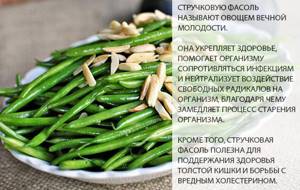
Harm of green beans
Due to the abundance of fiber, green beans can cause heaviness, bloating and discomfort in the stomach.
Green beans for weight loss
Possessing low calorie content, beans have gained fame as an ideal side dish for those who want to keep their weight under control (calorizer). By replacing your usual side dishes for lunch or dinner with a serving of green beans once or twice a week, you can gradually get rid of one kilogram per month without any special restrictions. They contain green beans, a diet rich in fiber, a zone diet, and many other nutritional principles and fasting days.
Selection and storage of green beans
When choosing fresh green beans, you should pay attention to the appearance of the pods - they should be elastic, without obvious damage or dark spots, and have a bright dark green color. If you have wet or, conversely, drying out pods in front of you, it is better to refrain from purchasing. Fresh green beans can be stored in the refrigerator for no longer than a week.
If you decide to choose frozen green beans, but you need to give preference to a packaged product, there is a guarantee that the beans, washed and peeled, do not require additional rinsing and can be cooked immediately. If the packaging is transparent, you need to carefully evaluate the color of the product - it should be dark green, there should be no lumps or pieces of ice, which indicates defrosting and subsequent re-freezing of the product. Frozen green beans will last in the freezer for up to six months. By the way, fresh green beans grown or purchased in large quantities can be frozen independently, which will retain all the beneficial properties of the product.
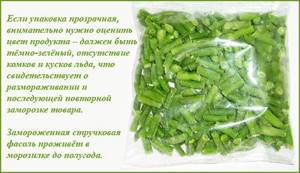
Varieties of green beans
You can and should grow green beans in any garden plot; at first the plant will delight you with bright fragrant flowers, and a little later – with an excellent harvest. Gardeners consider the following varieties to be the best: Oil King, Saksa 615, Caramel, Pobeditel.
Ideal dish for dinner
It is perhaps impossible to count how many different dishes and snacks can be prepared from green beans. Modern housewives are trying to look for universal recipes for complete meals. Here's one of them. Let's add a little meat to the side dish and we'll get a treat that doesn't require any extras.
And to reduce the nutritional value of the dish, just take chicken breast or turkey, and also stew green beans. In general, it can be blanched separately until al dente and served as a side dish for chicken.

Ingredients:
- fresh frozen chicken breast – one piece;
- salt, seasonings;
- fresh dill - half a bunch;
- tomato paste - two tablespoons. spoons;
- green beans – 350-400 g;
- garlic - a couple of cloves;
- carrot - one root vegetable;
- onion - one head;
- refined vegetable oil.
Preparation:
- If you used frozen chicken for cooking, then the meat should be left to thaw naturally.
- Next, remove the skin and surface film from it. Wash the breast thoroughly and dry it with a napkin.

- Cut the chicken breast into medium sized cubes.
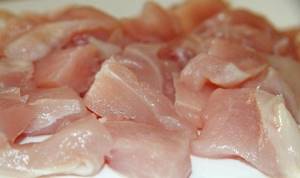
- Chop the peeled carrots into slices or halves of slices.
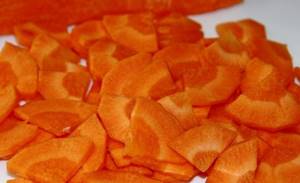
- Chop the onion into small cubes, strips or in the shape of half rings.

- Take the green beans out of the freezer.
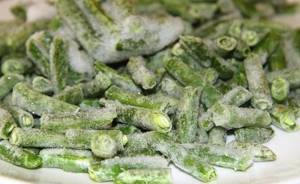
- Heat a little refined vegetable oil in a frying pan and first sauté the onion. The vegetable should lighten.

- Then add chopped carrots, mix well and fry until golden brown.
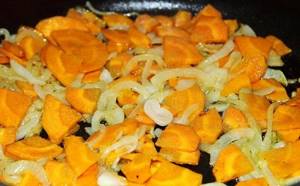
- Next step is chicken breast. Add it to the vegetables and fry over medium heat.

- A quarter of an hour is enough for the breast to cook. Next we will simmer it, so the product will not remain raw.

- Now add the beans and pour in about 150 ml of filtered water.
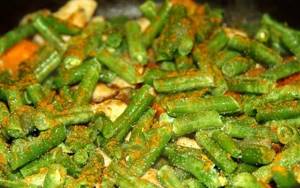
- Simmer everything in a sealed container for a third of an hour, and in the meantime chop the herbs and garlic.
- Together with tomato paste, add these ingredients to the dish.

- All that remains is to mix. Simmer for a few more minutes and serve. This treat will be tastier when served hot.
